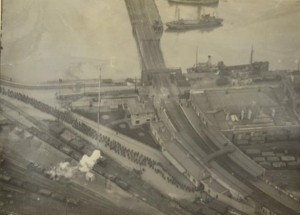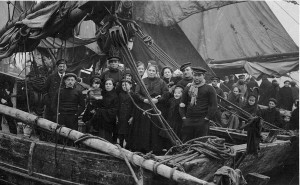Dr Will Butler, University of Kent
Over the past eight months, I have been working as the project manager and lead researcher for an exhibition at the Step Short premises in Folkestone, and a self-guided walking tour app of the town, taking in sights that were of significance during the First World War.
Aerial view of wartime Folkestone
The idea of the project was to provide a very local perspective of the war, and how it affected its local population. Throughout the war, Folkestone acted as one of the main thoroughfares for a plethora of different nationalities, those either escaping the European mainland, or making their way to it. Much is known of the Belgian refugees, and British, Canadian, and American soldiers who stayed and passed through Folkestone, but it is important to tell the story of those left behind: how the changing makeup of the town influenced its people, how they lived and worked, and how the town itself was altered during over four years of conflict.
Belgian Refugees in Folkestone
Naturally, Folkestone, “The Queen of the South Coast” as one handbook described it, as one of the most popular seaside resorts in Edwardian Britain, was used to an influx of people, especially during the summer months. Therefore, the rapid change in the demographic of the town was less of a culture shock than it may have been in other towns. There were few problems between the townspeople and its visitors, but this does not mean that there were no issues at all. Friction existed between soldiers and shopkeepers when high prices were charged; petty crime increased; prostitution became a real concern; and a whole host of regulations that restricted movement took its toll on how the town worked.
The relations, however, were, on the whole, harmonious. All concerned appeared to benefit from the arrangement- the town provided the soldiers and refugees with a comfortable environment to stay, and in turn, the inhabitants were afforded economic stability, and a whole host of entertainment opportunities, from musical performances to sporting events (Baseball had even been introduced to the town by 1918).
The exhibition will provide information and visual material to illustrate some of these changes and relationships, acting as a starting point for those interested in the history of Folkestone, and those with a wider interest in the home front, or the war in general. Additionally, the self-guided tour will demonstrate, through photographs and written information, how many locations were transformed by the war, and how they have changed subsequently. This culminates with a walk along the Leas to the newly erected Memorial Arch, which commemorates all those who passed through the town on their way to the front, or on their way home.


